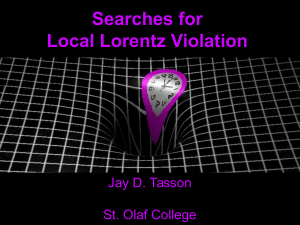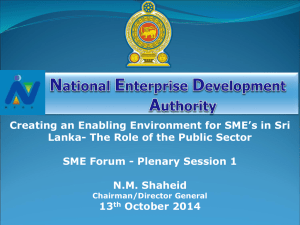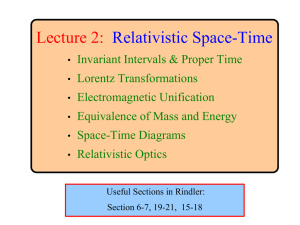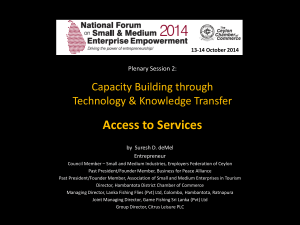Effective-field- theory description of Lorentz violation
advertisement
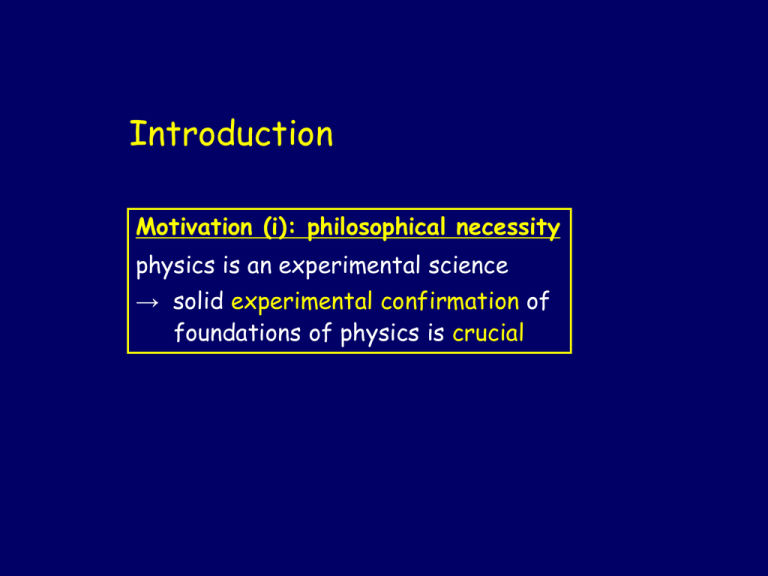
Introduction Motivation (i): philosophical necessity physics is an experimental science → solid experimental confirmation of foundations of physics is crucial Motivation (ii): discovery potential various approaches to physics beyond the Standard Model („quantum gravity“) can accomodate tiny violations of Relativity Issue: attainable E << quantum-gravity (QG) scale Planck suppression of QG observables common approach (top-down): scan predictions of a given theory for sub-Planck effects accessible with near-future technology, e.g., - novel particles (SuSy) - large extra dimensions & microscopic black holes - gravitational-wave background … bottom-up motivation: What can be measured with Planck precision? Is there a corresponding quantum-gravity effect? Symmetries: - allow exact theoretical prediction - are typically amenable to ultrahigh-precision (null) tests Tests of spacetime symmetries could probe Planck-scale physics Quantum gravity: likely to affect spacetime structure - More than 4 dimensions? - Non-commuting coordinates? - Discreteness? - “Foamy” structure? -… Outline Loop quantum gravity? Varying Scalars? Noncomm. geometry? Topology? Sec B: Mechanisms for Lorentzand CPT breakdown Strings? Other? Sec A: Construction of general test framework (SME) for violations of Lorentz and CPT symmetry Sec C: Phenomenology and exp. tests quantum optics satellites Penning traps astrophysics other A. The Standard-Model Extension (SME) A test framework that allows for deviation from exact Lorentz symmetry is desirable: - to identify suitable tests - to interpret and analyze experimental observations - to compare tests in different physical systems - to study the theoretical consistency Example: CPT symmetry - if CPT holds particle mass m1 = antiparticle mass m2 - if CPT is broken ??? (in SME, m1 = m2 is still OK) - usual CPT test for Kaons uses model only valid for Kaon interferometry precludes comparison with other tests How can one get a test framework for Lorentz violation? E ~EPlanck underlying physics (strings, loop gravity, noncommutative geometry, SUGRA, ...) ? ~ELHC Problem 1: many theory approaches Problem 2: low-E limit can be unclear effective theory (SME test model) SME must be constructed by hand guided by gen. principles Advantage: generality; independence of underlying physics Construction of the SME - k, s, ... coefficients for Lorentz violation - minimal SME fermion 44, photon 23, ... - generated by underlying physics (Sec B) - amenable to ultrahigh-precision tests (Sec C) Colladay, Kostelecký ‘97;’98; Kostelecký ‘04; Coleman, Glashow ‘99 Remarks: - can consider operators of higher mass dimension (Myers, Pospelov ‘03; Anselmi, Halat ’07; …) - in gravity context, the above explicit Lorentz breaking is typically inconsistent spont. Lorentz violation needed (Kostelecký ‘03; Jacobson, Mattingly ‘04) sample theoretical investigations of the SME - radiative corrections (Jackiw, Kostelecký '99; Y.-L. Wu’s talk?) - causality and stability (Kostelecký, R.L. '01) - gravity: LV must be dynamical (e.g., spontaneous) (Kostelecký '04) - supersymmetry (Berger, Kostelecký '02) - "Anti-CPT Theorem" (Greenberg '02) - one-loop renormalizability (Kostelecký, Lane, Pickering '02) - dispersion relations and kinematical analyses (R.L. '03) - generalization of conventional math. formulas (R.L. '04; '06) - symmetry studies (Cohen, Glashow '06; Hariton, R.L. '07) -... B. Mechanisms for Lorentz breakdown (1) Spontaneous Lorentz breaking in string theory conventional case: gauge symmet. string theory: Lorentz symmetry Kostelecký, Perry, Potting, Samuel ’89; ’90; ’91; ’95; '00 (2) Cosmol. varying scalars (e.g., fine-structure parameter) intuitive argument: small scalar spacetime large scalar gradient of the scalar selects pref. direction mathematical argument: = (x) ... varying coupling , ... dynamical fields Integration by parts: slow variation of : Kostelecký, R.L., Perry '03; Arkani-Hamed et al. '03; X. Zhang’s talk? Other mechanisms for Lorentz violation Noncommutative geometry (QM of spacetime points) Seiberg-Witten: usual Minkowski coordinates x SME terms emerge: e.g., Carroll et al. ‘01 Topology (1 spatial dim. is compact: large radius R) Vacuum fluctuations along this dim. have periodic boundary conditions preferred direction in vacuum calculation: ... Klinkhamer ‘00 C. Phenomenology and Tests Example (1): free particles dispersion relation now contains Lorentz-violating terms: E usual 4-fold degeneracy for is lifted Sample effect: threshold modification in particle reactions kinematical changes in particle collisions: p dependence of E is modified: Energy-momentum conservation: thresholds may be shifted decays/reactions normally allowed may now be forbidden decays/reactions normally forbidden may now be allowed kinematical modifications in existing effects Vacuum Cherenkov radiation: e e + g (D. Anselmi’s talk?) - not seen for 104.5 GeV electrons at LEP can extract bound: certain LV < 10-11 (Hohensee, R.L., Phillips, Walsworth, PRL ’09) Sidereal variations of the Compton edge: g+ e- g + e- not seen at ESRF’s GRAAL facility can extract bound: certain LV < 10-13 (Bocquet et al., PRL ’10; Bo-Qiang Ma’s talk?) GBR measurements (Zi-Gao Dai’s and Xue-Feng Wu’s talks?) UHECR anisotropies (Xiao-Bo Qu’s talk?) GZK cut-off modifications (Xiao-Jun Bi’s talk?) Photon birefringence (Ming-Zhe Li’s and Lijing Shao’s talks?) Example (2): corrections to bound-state levels Conventional electrodynamics: in QED Lagrangian, coupling of E, B fields to electrons is: nontrivial potential A affects, e.g., atomic spectra: - Stark effect - Zeeman effect -... How can Lorentz/CPT breakdown affect matter? SME Lagrangian contains Expect: Lorentz/CPT violation shifts energy levels Antihydrogen spectroscopy: - ALPHA, ASACUSA, ATRAP will trap & study anti H projected bound: certain LV < 10-26 GeV (Bluhm, Kostelecký, Russell, PRL ‘99) Clock-comparison type tests: - clock = atomic/nuclear transition many bounds: certain LV < 10-20…-30 GeV (many papers; e.g., nEDM, PRL ‘09, EPL ‘10) Muonic Hydrogen/Helium spectrum: - What are the level shifts? What (muon) bounds can be extracted? (R.L., work in progress) Other phenomenological studies performed within SME Hydrogen and Antihydrogen spectroscopy Bluhm, Kostelecký, Russell '99 Phillips et al. '01 Penning-Trap experiments Bluhm, Kostelecký, Russell '97; '98 Gabrielse et al. '99 Mittelman et al. '99 Dehmelt et al. '99 Studies of muons Bluhm, Kostelecký, Lane '99 Hughes et al. '00 (g-2) collaboration ‘08 Clock-comparison tests Kostelecký, Lane '99 Hunter et al. '99 Stoner '99 Bear et al. '00 Cane et al. ‘04 Satellite-based tests Kostelecký et al. '02; '03 ACES PARCS? RACE? SUMO? OPTIS Tests involving photons and radiative effects Carroll, Field, Jackiw '90 Colladay, Kostelecký '98 Kostelecký, Mewes '01; '02; ‘06; ‘07 Lämmerzahl et al. '03 Lipa et al. '03 Stanwix et al. '05 Klinkhamer et al. '07 Gravity Bailey, Kostelecký '06 Battat et al. ‘07 Müller et al. ‘08 Studies of baryogenesis Bertolami et al. '97 Studies of neutrinos Barger, Pakvasa, Weiler, Whisnant '00 Kostelecký et al. '03; '04 Katori et al. '06 Barger, Marfatia, Whisnant ‘07 Kinematical studies of cosmic rays (see many talks at this meeting) Coleman, Glashow '99 Bertolami, Carvalho '00 R.L. '03 Altschul ‘06; ‘07 Studies of neutral-meson systems Kostelecký et al. '95; '96; '98; '00 KTeV Collaboration, Hsiung et al. '99 FOCUS Collaboration, Link et al. '03 OPAL Collaboration, Ackerstaff et al. '97 DELPHI Collaboration, Feindt et al. '97 BELLE Collaboration BaBar Collaboration ‘08 Summary presently no credible exp. evidence for Relativity violations, but: (1) various theoretical approaches to quantum gravity can cause such violations (2) at low E, such violations are described by SME test framework (eff. field theory + background fields) (3) high-precision tests (gravity waves, astrophysical studies, satellite missions, atomic clocks, interferometry, ...) possible ? Bounds on SME coeff. for ”Data Tables for Lorentz and CPT Violation” arXiv: 0801.0287v4 matter Bounds on photon SME ”Data Tables for Lorentz and CPT Violation” arXiv: 0801.0287v4 coeff.

